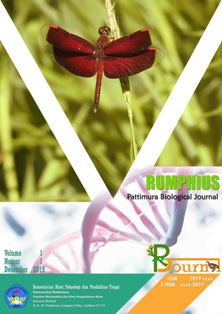IN VITRO ANTAGONISM OF THE ISOLATE MUSHROOM Trichoderma harzianum TO Fusarium oxyzporum f. sp. Cubense CAUSES WILT DISEASE IN BANANA KEPOK (Musa paradisiaca normalis)
Abstract
Trichorderma harzianum is a soil native fungus that is beneficial because it has high antagonistic properties against plant pathogenic fungi. Control mechanisms can be: antibiosis, parasitism, competition and hyphae interference. T. harzianum as a biological control agent for the pathogenic fungus Fusarium oxyforum f. sp. Cubense is an alternative to control this pathogenic fungus, without causing a negative impact on the environment. The aim of the study was to determine whether Trichodernma harzianum isolates Piru, Kairatu and Uraur could suppress the growth of the fungus Fusarium oxyforum f. sp. cubense and Trichorderma harzianum which isolates (Piru isolate, Kairatu isolate and Uraur isolate) had faster inhibition against Fusarium oxyforum f. sp. cubense causes wilt disease on banana kepok (Musa paradisiaca normalis) in vitro with antagonism test. The research was conducted in 2 places, namely in the HPT BPTPH laboratory in Maluku province and continued in the microbiology laboratory at FMIPA Unpatti. The research method used was laboratory experimental in nature by using a completely randomized design with factorial pattern with three treatments and three replications. The results showed that the cause of wilt disease in banana plants was Fusarium oxyforum f. sp. Cubense. Antagonism test in vitro showed that T. harzianum Piru isolate showed the highest inhibition zone (70.87%), both Kairatu isolates (45.27%), and the lowest by Uraur isolate (32.61%) so that it can be said that T. harzianum has the potential to inhibit the growth of Fusarium fungus. oxyforum f. sp. Cubense.
Downloads
References
Semangun, H. 1996. Introduction to Plant Disease Science. Gadjah Mada University Press, Yogyakarta.
Maluku Provincial Agriculture Service. 2004. Report on Increasing the Technical Knowledge of Field Officers and Functional Personnel. Maluku Provincial Agriculture Service, Food Crop and Horticulture Protection Center, Ambon.
Sudantha, I. M. 1993. Control of the fungus Sclerotium oryzae Catt. Biologically Using Antagonistic Fungi on Upland Rice Plants. Indonesian Phytopathology Association. Yogyakarta.
Syahnen., N. Ramli., M. Thahir. 2006. Guidelines for Exploration, Propagation and Use of Trichoderma Fungi. North Sumatra Plantation Plant Protection Plantation Center, Medan.
Dharmaputra., O. Setyawati., H. Susilo and S. Ambarwati. 1993. Fusarium Association with Several Plants That Have Economic Importance in West Java and Their Mycotoxin Production in Corn Seeds. Seamoe BIOTROP. Indonesian Phytopathology Association. Yogyakarta.
Semangun, H. 1991. Horticultural Plant Diseases in Indonesia. Gadjah University Press. Yogyakarta.
Tjahjadi N. 1989. Plant Pests and Diseases. Kanisius, Yogyakarta.
Sudantha, H. 1992. Efforts to Biologically Control Fusarium Wilt in Tomato Plants. Indonesian Phytopathology Association. Yogyakarta.
Anggriani and N. H. A. Yahya. 1993. Antagonism Test Between Trichoderma spp. With Sclerotium rolfisii Causes of Germ Blight in Soybeans. Bogor Food Crop Research Institute, Yogyakarta.
Nasution, P., Periadnadi and Nurmiati. 2017. Growth Speed of Mold (Trichoderma harzianum Rifai A1300-F006) Cellulase Activity in Handling Cellulose Waste. Journal of Biological Sciences 4(1):35-40.
Authors who propose a manuscript and have it approved for publication know that the manuscript will be registered and become part of the RPBJ. Authors and readers understand that this journal is open and all its contents can be accessed freely, provided that RPBJ is still listed as the source of information. The hope is that this journal can become a vehicle for exchange and scientific knowledge for society and the scientific community, especially in the field of Biology and other branches of science.









